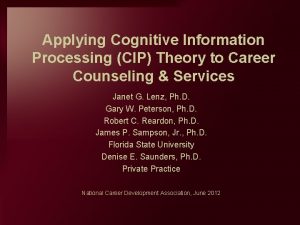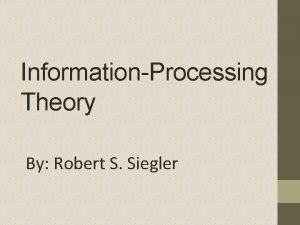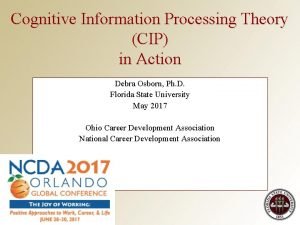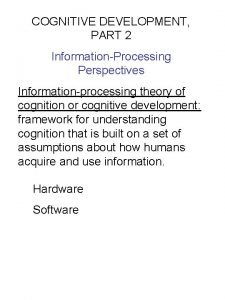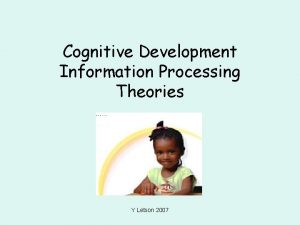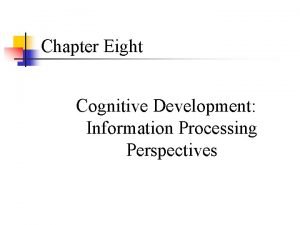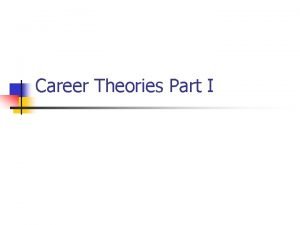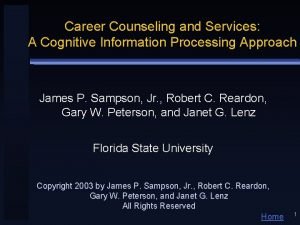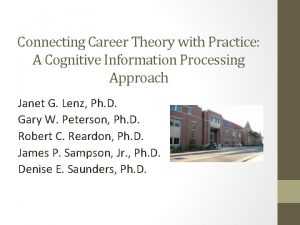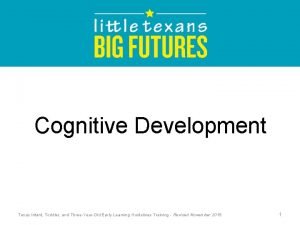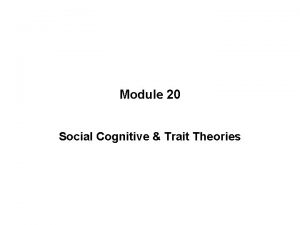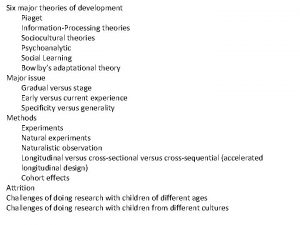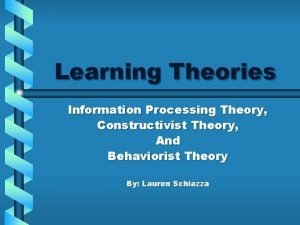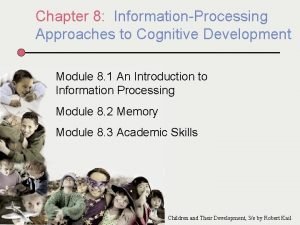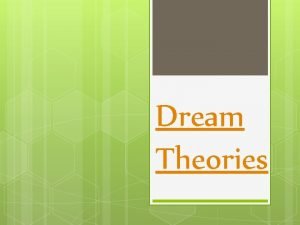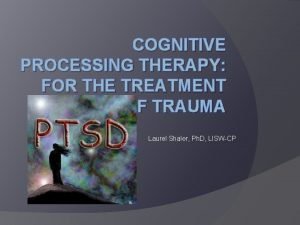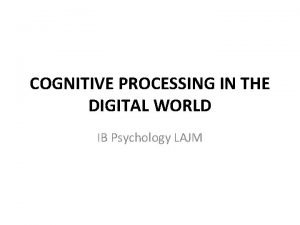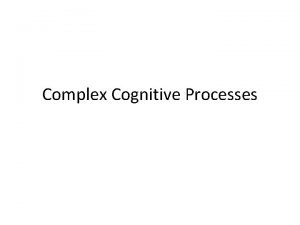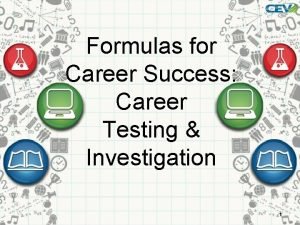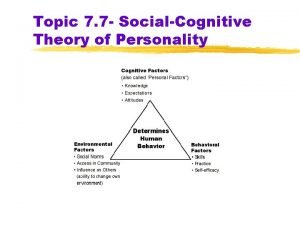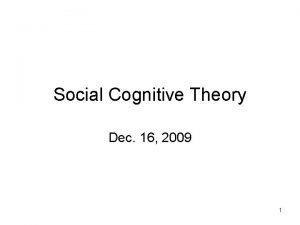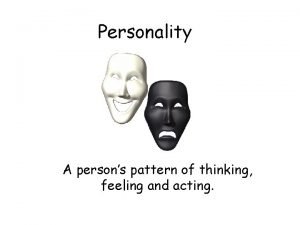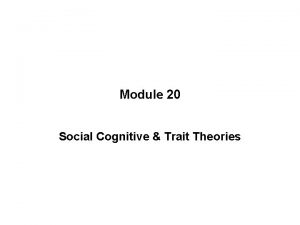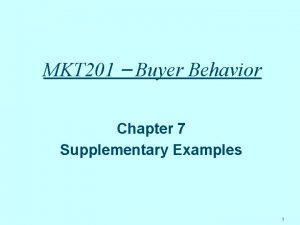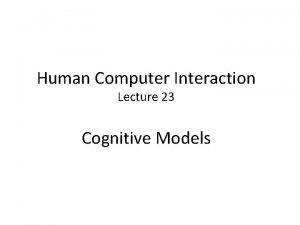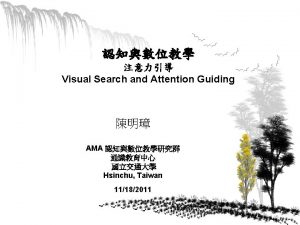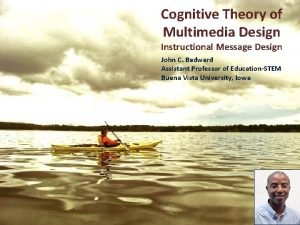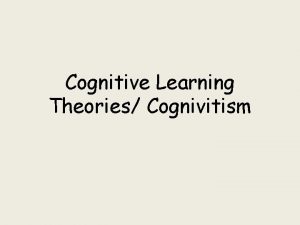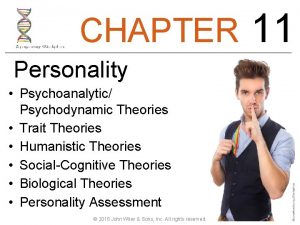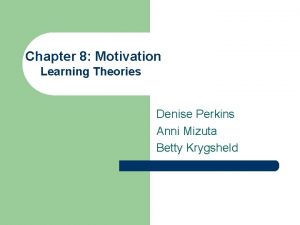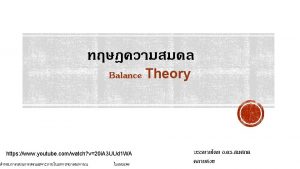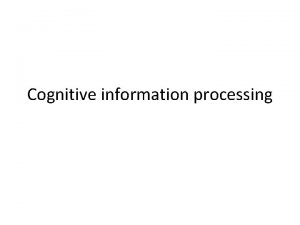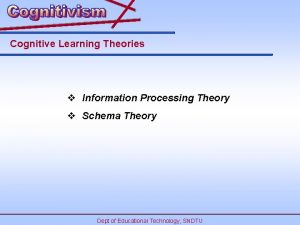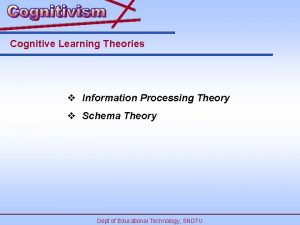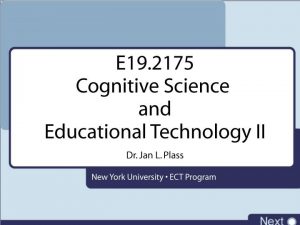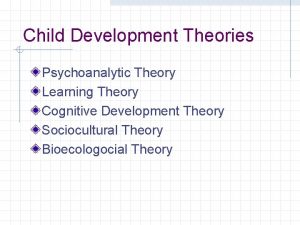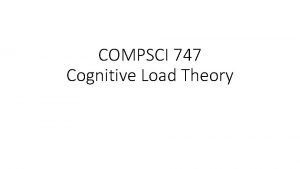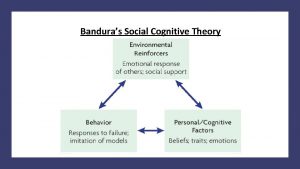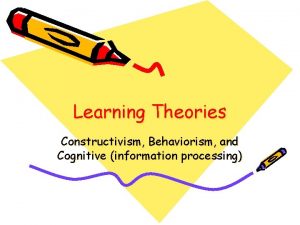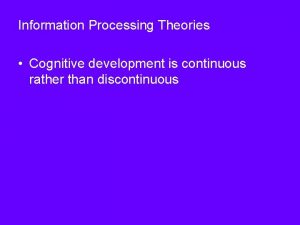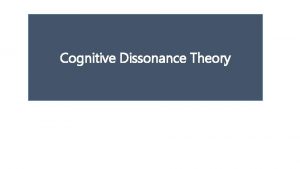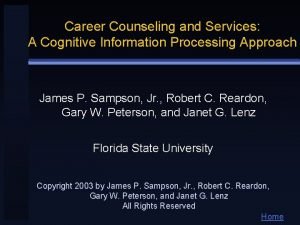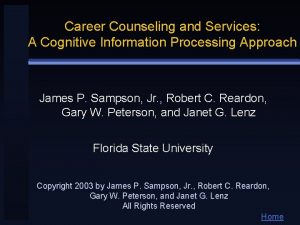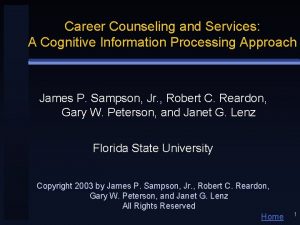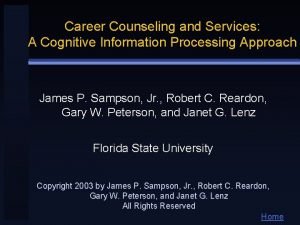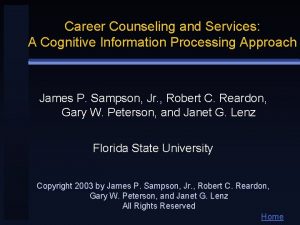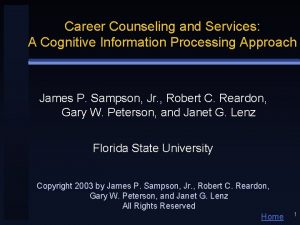Career Theories Part I Cognitive Information Processing Theory




































- Slides: 36

Career Theories Part I

Cognitive Information Processing Theory • • Cognitive means of, or relating to mental activity such as thinking, remembering, learning or using language. Cognitive information processing (CIP) theory relates to the acquisition of career problem solving and decision making skills.

Cognitive Information Processing Theory • • • Began in 1971 and builds upon the selfdirected career service delivery strategies. Developed at Florida State University. Test given to see whatever path the patient of student should take, and he or she is most interested in.

Cognitive Information Processing Theory • • • Recommended for students especially with learning disabilities, because of their high drop out rate. Recommended for youth over adults. Pathways- activities in which students take on unfamiliar roles to enhance understanding and motivation.

Cognitive Information Processing Theory • Cognitive interventions involves setting goals for students, clear demonstration of task, self help, and talk for students.

Cognitive Information Processing Theory • n n n Purposes. To help people to make and implement effective career decisions. To enhance the counseling processing. To assist entry into the primary labor model.

Cognitive Information Processing Theory • • Findings indicate that the information acquisition construct is significantly related to memory, thinking, sense making, improvising, as well as information dissemination and implementation. CIP is an emergent career theory, designed to examine how individuals engage in career problem solving and decision-making.

Cognitive Information Processing Theory • • • Primary focus of this approach is on memory career problem solving and decision-making. The processing of information can be effected by applying different controls to the individual, encouraging long-term memory, and retention. First, you receive a stimuli through your senses.

Cognitive Information Processing Theory • After you hear the sound, your brain puts this information into the sensory register.

Cognitive Information Processing Theory • • Then, the information is placed into short-term memory. If the information is not encoded from short-term memory to long-term memory, the information is lost. Once in long term memory, the information is ready for retrieval.

Person Environmental Correspondent Theory n n Works to integrate insights from constructivist socio-cultural and embodies models of acting, thinking, and feeling Individual action is always directed toward some physical or psychological object

Person Environmental Correspondent Theory n n n The context in which an action occurs also plays a central role in the emergencies and execution of action Act is meditated around the object; all actions are premeditated Sought to understand conditions under which group discussion enhances and weakens individual bias in the attribution of attitudes

Person Environmental Correspondent Theory n Theory is about how people make causal explanations:

Person Environmental Correspondent Theory n n Basic ideas 1. The present is the most important aspect of the person, and humanists focus on the here and now rather than looking at the past or trying to predict the future

Person Environmental Correspondent Theory n n 2. Humanistic theory is reality based and to be psychologically healthy people must take responsibility for themselves, whether the person's actions are positive or negative 3. The individual, merely by being human, posses an inherent worth. Actions may not be positive, but this does not negate the value of the person

Person Environmental Correspondent Theory n 4. The goal of life should always be to achieve personal growth and understanding. Only through self-improvement and selfknowledge can one truly be happy

Person Environmental Correspondent Theory n n Weaknesses 1. The biggest criticism appears to center around its lack of concrete treatment approaches aimed at specific issues.

Person Environmental Correspondent Theory n n 2. With the basic concept behind theory being free will, it is difficult to both develop a treatment technique and study the effectiveness of this technique 3. Secondly, there are those who believe humanistic theory falls short in it's ability to help those with more severe personality or mental health pathology

Person Environmental Correspondent Theory n 4. It may show positive benefits for a minor issue, using the approach of Roger's to treat schizophrenia would seem ludicrous.

Person Environmental Correspondent Theory n n 5. Further, in their review of different approaches to positive psychology, Seligman & Csikszentmihalyi (2000) notes that the early incarnations of humanistic psychology lacked a cumulative empirical base 6. Some directions encouraged self-centeredness. Rowan (2001) believes that these suspicions are understandable as long as a large amount of time is spent on discussing such issues as the self and self-actualization

Person Environmental Correspondent Theory n n n Despite these problems, theory has been incorporated into many differing views on psychotherapy and human change Many argue now that a humanistic undertone in treatment provides a nice foundation for change While it may not be sufficient, it may still be necessary for a significant personality change to occur

Supers Development Theory • • Most career counselors credit Donald Super for their understanding of life roles Theories of development reflect the concept of life roles when addressing identity Postmodern or constructivist counseling process based on the clients subjective narrative or life story Helps clients to explore past and present to help them look toward the future

Supers Development Theory • • • It is more than “test them and tell them” Counselor must de-construct clients life, so they can better understand themselves Because of de-construction clients have the opportunity to construct their future based on the personal meanings that they wish to implement in their lives

Supers Development Theory n n Relationships and Emotions Client draws a life space map Counselor provides a variety of exploratory prompts Represents relationships and emotions

Supers Development Theory n n The client will then draw a circle on a blank piece of paper anywhere on the page to represent how the client is currently feeling with his or her space Next step is for the client to draw a circle for each person in the clients world

Supers Development Theory n A double ring is drawn around those that concern the client

Supers Development Theory n n Life Line Reveals clients past and present life story

Supers Development Theory n Client instructed to draw a line down the middle of the paper and write their date of birth and today’s date

Supers Development Theory n Chapters are represented by life stages (schooling, job, etc)

Supers Development Theory n n Use this to see what job family member have/ goes back three generation Also used to see how much family means to client

Supers Development Theory n n Life Circles Activity begins with discussion of what life roles are and involves the client in identifying the life roles he or she has experienced and is currently experiencing

Supers Development Theory n n Client asked to draw a circle representing their involvement in their life roles that they are experiencing (the bigger the circle the more involvement) On a separate sheet of paper, clients are asked to draw the things that will be important to them in the future, and to see if circle determines importance

Supers Development Theory n Discussion concerns: conflicting roles, complimentary roles, and compensatory roles

Supers Development Theory n n n De-construction Phase of “open space” This opening will provide motivation and direction for client in the future Widens clients definition of career and allows client to be more open minded At this point a series of what if questions are asked Client is encouraged to overcome stereotypes

Supers Development Theory n n Construction Focuses on the future of the clients life

Supers Development Theory n n n Action plans are developed that identify the steps to take anticipated barriers, and resources to overcome the barriers Future self-concept is linked to motivation with specific organized concrete action steps toward future goals Steps are actions or behaviors that can be enacted to realize positive states of being
 Cognitive information processing theory career
Cognitive information processing theory career Siegler’s information processing skills
Siegler’s information processing skills Cognitive information processing theory
Cognitive information processing theory Information processing theory of cognitive development
Information processing theory of cognitive development Information processing theory of cognitive development
Information processing theory of cognitive development Information processing theory by atkinson and shiffrin
Information processing theory by atkinson and shiffrin Cognitive information processing
Cognitive information processing In the cognitive information-processing pyramid
In the cognitive information-processing pyramid Cognitive information processing pyramid
Cognitive information processing pyramid Piagetian and information processing theories 8-18 months
Piagetian and information processing theories 8-18 months Cognitive and non cognitive religious language
Cognitive and non cognitive religious language Trait theory vs social cognitive theory
Trait theory vs social cognitive theory Information processing theory by atkinson and shiffrin
Information processing theory by atkinson and shiffrin What is the information processing theory
What is the information processing theory Hypothetical reasoning piaget
Hypothetical reasoning piaget The information processing approach
The information processing approach Cognitive development theory dreams
Cognitive development theory dreams A-b-c worksheet cpt
A-b-c worksheet cpt Cognitive processing in the digital world
Cognitive processing in the digital world Complex cognitive processes
Complex cognitive processes 16 national career clusters
16 national career clusters Formulas for career success
Formulas for career success Cognitive perspective of personality
Cognitive perspective of personality Social cognitive theory motivation
Social cognitive theory motivation Social cognitive theory of personality examples
Social cognitive theory of personality examples Social cognitive theory of personality examples
Social cognitive theory of personality examples Cognitive dissonance theory example
Cognitive dissonance theory example Jerome bruner cognitive theory
Jerome bruner cognitive theory Cognitive complexity theory in hci
Cognitive complexity theory in hci Beck cognitive theory
Beck cognitive theory Cognitive theory of multimedia learning
Cognitive theory of multimedia learning Instructional message design
Instructional message design Cognitive learning theory
Cognitive learning theory Social cognitive theory of personality examples
Social cognitive theory of personality examples Eccles expectancy value theory
Eccles expectancy value theory Cognitive learning theory in marketing
Cognitive learning theory in marketing Balance theory
Balance theory
